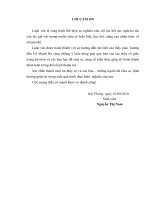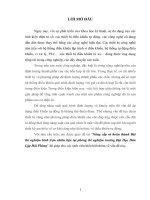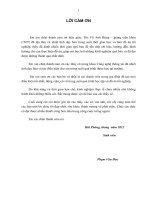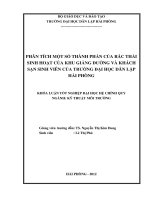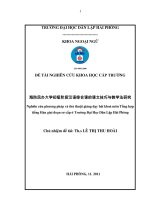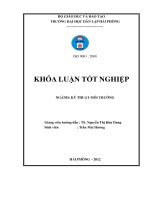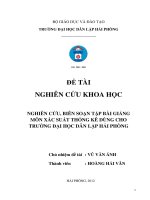Nghiên cứu thực nghiệm về hiệu quả của các hoạt động đọc tự chọn đối với khả năng đọc của sinh viên không chuyên Anh trường Đại học Dân Lập Hải Phòng
Bạn đang xem bản rút gọn của tài liệu. Xem và tải ngay bản đầy đủ của tài liệu tại đây (919.19 KB, 72 trang )
V
V
I
I
E
E
T
T
N
N
A
A
M
M
N
N
A
A
T
T
I
I
O
O
N
N
A
A
L
L
U
U
N
N
I
I
V
V
E
E
R
R
S
S
I
I
T
T
Y
Y
,
,
H
H
A
A
N
N
O
O
I
I
U
U
N
N
I
I
V
V
E
E
R
R
S
S
I
I
T
T
Y
Y
O
O
F
F
L
L
A
A
N
N
G
G
U
U
A
A
G
G
E
E
S
S
A
A
N
N
D
D
I
I
N
N
T
T
E
E
R
R
N
N
A
A
T
T
I
I
O
O
N
N
A
A
L
L
S
S
T
T
U
U
D
D
I
I
E
E
S
S
F
F
A
A
C
C
U
U
L
L
T
T
Y
Y
O
O
F
F
P
P
O
O
S
S
T
T
-
-
G
G
R
R
A
A
D
D
U
U
A
A
T
T
E
E
S
S
T
T
U
U
D
D
I
I
E
E
S
S
NGUYỄN VIỆT ANH
AN EXPERIMENTAL STUDY ON THE EFFECT OF THE
SELF-SELECTED READING ACTIVITIES ON HAIPHONG
PRIVATE UNIVERSITY’S ENGLISH NON-MAJORS’
READING PROFICIENCY
Nghiên cứu thực nghiệm về hiệu quả của các hoạt động đọc tự chọn đối với khả năng đọc của
sinh viên không chuyên Anh trường Đại học Dân Lập Hải Phòng
M.A. MINOR PROGRAMME THESIS
F
F
i
i
e
e
l
l
d
d
:
:
English Teaching Methodology
C
C
o
o
d
d
e
e
:
:
6
6
0
0
.
.
1
1
4
4
.
.
0
0
1
1
.
.
1
1
1
1
HANOI, 2014
V
V
I
I
E
E
T
T
N
N
A
A
M
M
N
N
A
A
T
T
I
I
O
O
N
N
A
A
L
L
U
U
N
N
I
I
V
V
E
E
R
R
S
S
I
I
T
T
Y
Y
,
,
H
H
A
A
N
N
O
O
I
I
U
U
N
N
I
I
V
V
E
E
R
R
S
S
I
I
T
T
Y
Y
O
O
F
F
L
L
A
A
N
N
G
G
U
U
A
A
G
G
E
E
S
S
A
A
N
N
D
D
I
I
N
N
T
T
E
E
R
R
N
N
A
A
T
T
I
I
O
O
N
N
A
A
L
L
S
S
T
T
U
U
D
D
I
I
E
E
S
S
F
F
A
A
C
C
U
U
L
L
T
T
Y
Y
O
O
F
F
P
P
O
O
S
S
T
T
-
-
G
G
R
R
A
A
D
D
U
U
A
A
T
T
E
E
S
S
T
T
U
U
D
D
I
I
E
E
S
S
NGUYỄN VIỆT ANH
AN EXPERIMENTAL STUDY ON THE EFFECT OF THE
SELF-SELECTED READING ACTIVITIES ON HAIPHONG
PRIVATE UNIVERSITY’S ENGLISH NON-MAJORS’
READING PROFICIENCY
Nghiên cứu thực nghiệm về hiệu quả của các hoạt động đọc tự chọn đối với khả năng đọc của
sinh viên không chuyên Anh trường Đại học Dân Lập Hải Phòng
M.A. MINOR PROGRAMME THESIS
F
F
i
i
e
e
l
l
d
d
:
:
English Teaching Methodology
C
C
o
o
d
d
e
e
:
:
6
6
0
0
.
.
1
1
4
4
.
.
0
0
1
1
.
.
1
1
1
1
S
S
u
u
p
p
e
e
r
r
v
v
i
i
s
s
o
o
r
r
:
:
D
D
r
r
.
.
N
N
g
g
u
u
y
y
ê
ê
̃
̃
n
n
T
T
h
h
i
i
̣
̣
N
N
g
g
o
o
̣
̣
c
c
Q
Q
u
u
y
y
̀
̀
n
n
h
h
HANOI, 2014
i
DECLARATION
I declare that this thesis entitled: “An experimental study on the effect of the
self-selected reading activities on Haiphong Private University’s English non-
majors’ reading proficiency” is my original research work, and that all the
resources that I have use or quoted have been acknowledged by means of complete
reference.
Hanoi,2014
Signature:
Nguyễn Việt Anh
ii
ACKNOWLEDGEMENTS
On the completion of the study, I wish, first of all, to express my deepest
gratitude to my supervisor Dr. Nguyê
̃
n Thi
̣
Ngo
̣
c Quy
̀
nh . Without her enthusiastic
guidance and precious encouragement, the study could not be fulfilled.
My sincere thanks also go to my colleagues in Haiphong Private University
for their useful suggestions which have helped much in completing the study.
I owe a special debt of gratitude to my students, who helped me a lot during
the process of the study
Last but not least, I would like to give my heartfelt thanks to every member
in my family as well as our friends. Without their spiritual support, this study could
not have come up in the present form.
iii
ABSTRACT
How to teach reading effectively is becoming a big matter in universities. In
order to promote students‟ activeness as well as to enhance their reading
proficiency, “an experimental study on the effect of the self-selected reading
activities on Haiphong Private University‟s English non-majors‟ reading
proficiency” was carried out. Quasi-experimental design was the main research
method employed in this study to find out the answer about students‟ progress after
the implementation of the research. In addition, so as to get students‟ feedback on
the effect of self-selected reading activities, a survey questionnaire is designed to
search needed information. The study showed positive results with the progress of
students in experimental group. Besides, students expressed their interest as well as
satisfaction to self-selected reading activities through student questionnaire. It can
be said that the results collected in this study had great significance in applying self-
selected reading activities to students at different levels.
iv
TABLE OF CONTENTS
Page
DECLARATION……………………………………………………………….
i
ACKNOWLEDGEMENTS…………………………………………………
ii
ABSTRACT…………………………………………………………………….
iii
TABLE OF CONTENTS………………………………………………… …
iv
LIST OF TABLES………………………………………………………… …
vii
LIST OF ABBREVIATIONS…………………………………………………
viii
PART A. INTRODUCTION………………………………………………
1
1. Rationale……………………………………………………………………
1
2. Aims of the study…………………………………………………………….
2
3. Research questions……………………………………………………………
2
4. Scope of the study………………………………………………………….…
3
5. Research methods………………………………………………………….…
3
6. Design of the study……………………………………………………
3
PART B. DEVELOPMENT……………………………………………… …
4
CHAPTER 1. LITERATURE REVIEW………………………………… …
4
1.1. Reading…………………………………………………………………….
4
1.1.1. Definition of reading………………………………………………
4
1.1.2. Intensive and extensive reading……………………………… …
5
1.1.2.1. Intensive reading…………………………………………
5
1.1.2.2. Extensive reading………………………………………
6
1.1.3. Phases in teaching reading………………………………… ……
9
1.1.3.1. Pre-reading activities………………………………….…
9
1.1.3.2. While-reading activities……………………………….…
9
1.1.3.3. Post-reading activities……………………………………
9
1.2. Self-selected reading………………………………………………………
10
1.2.1. What is self-selected reading? ……………………………………
10
v
1.2.2. Benefits of self-selected reading…………………………………
11
1.3. Group work…………………………………………………………… …
12
1.3.1. What is group work? ………………………………………… …
12
1.3.2. Why use groups? ……………………………………………….…
13
1.3.3. Group formation…………………………………………… ……
15
1.3.3.1. Group size…………………………………… …………
15
1.3.3.2. Group composition………………………………………
15
1.3.4. Criteria for assessing group work………………………………
16
CHAPTER 2. METHODOLOGY…………………………………………….
18
2.1. Experimental research design…………………………………………….
18
2.1.1. Experimental research…………………………………………….
18
2.1.2. Why was quasi-experimental research adopted in the
study? ……………………………………………………………………
18
2.1.3. Variables…………………………………………………………
19
2.2. Setting………………………………………………………………………
19
2.3. Participants………………………………………………………………
20
2.4. Data collection……………………………………………………………
20
2.4.1. Group work for self-selected reading……………………………
20
2.4.1.1. Group division……………………………………… …
20
2.4.1.2. Requirements for group work……………………………
21
2.4.1.3. Self-selected reading assessment………………………
23
2.4.2. Pretest and posttest………………………………………………
25
2.4.2.1. The tests………………………………………………….
25
2.4.2.2. Statistical concepts in experimental research……………
26
2.4.2.2.1. Mean……………………………………………
26
2.4.2.2.2. Mode……………………………………………
27
2.4.2.2.3. Variance and Standard Deviation (SD)… ……
27
2.4.2.2.4. CV………………………………………………
28
2.4.2.2.5. DF (degree of freedom)………………………
29
vi
2.4.2.2.6. T-test……………………………………………
30
2.4.3. Student questionnaire……………………………………………
31
CHAPTER 3: FINDINGS AND DISCUSSION………………………… …
32
3.1. Findings……………………………………………………………………
32
3.1.1. Comparison of the pretest scores between the experimental
group and control group……………………………………….…
32
3.1.2. Comparison of the pretest and posttest scores in the
experimental research……………………………………………
33
3.1.3. Comparison of the posttest scores between the
experimental group and control group…………………………
34
3.1.4. Students’ attitudes towards self-selected reading activities………
35
3.1.4.1. Students‟ points of views on the items appeared in
their classmates‟ presentation……………………………
35
3.1.4.2. Students‟ viewpoints on reading materials
supplied by their classmates………………………………
36
3.1.4.3. Students‟ ideas on reading tasks following reading
materials…………………………………………… ……
37
3.1.4.4. Students‟ opinions on their chance to contribute in
self-selected reading activities……………………………
38
3.1.5. Students’ opinions on their self-selected reading activities………
39
3.2. Discussion……………………………………………………………… …
40
PART C. CONCLUSION…………………………………………… ……
42
1. Concluding remarks………………………………………………………
42
2. Limitations……………………………………………………………………
43
3. Suggestions for further studies………………………………… ……… …
43
REFERENCES…………………………………………………………………
44
APPENDICES………………………………………………………………….
I
vii
LIST OF TABLES
Page
Table 1: Topics for self-selected reading………….………….…………………
21
Table 2: Mode of the pretest and post test scores of the two groups………….
27
Table 3: The pretest scores between the experimental group and control
group………….………….………….………….………….………………
32
Table 4: The pretest and post test scores within the experimental group…….
33
Table 5: The posttest scores between the experimental group and
control group………….………….………….………….………….… ……
34
Table 6: Students’ opinions on items appeared in their classmates’ self-
selected reading………….………….………….………….………….……
35
Table 7: Students’ viewpoints on self-selected reading materials
supplied by their classmates………….………….………….……………
36
Table 8: Students’ ideas on tasks following the self-selected reading texts…
37
Table 9: Frequency of contributing to students’ classmates’ self-
selected reading presentation………….………….………….…………
38
Table 10: Students’ opinions on their self-selected reading activities…….…
39
viii
LIST OF ABBREVIATIONS
KET
PET
CV
: Key English Test
; Preliminary English Test
: Coefficient of variation
M
: Mean
SD
: Standard Deviation
N
X
: Number of sampled students
: Individual sampled students
DF
: Degree of freedom
T
: Obtained value
P
: Probability
1
PART A. INTRODUCTION
1. Rationale
It can be said that among four basic English skills reading seems to be the
skill that makes students feel the most sleepy and boring in reading periods. In fact,
in teacher-centered or textbook-centered classrooms, teachers often dictate to
students what to read during instructional time. This itself makes students passive
and reduce their interest in reading. It is sometimes uncomfortable for students to
read what they do not really like. However, if they are allowed to self select what
they want to read, everything can be remarkably improved. Self-selected reading
will not only build an intrinsic motivation for reading but also increase likelihood of
deeper reading. Because of the fact that when students are eager for topics and kinds
of information they want to get and find it necessary to read, they have a tendency
to spend more time on reading and of course the more they read, the better they are.
It cannot be denied that students can benefit a lot through self-selected
reading. Reading, as we have known, both helps students enhance their vocabulary
and their knowledge of phonetics, semantics, pragmatics……, etc. and is a very
effective means of providing them with real life information. Clearly, when students
self select materials and read them intentionally and regularly, besides reading skill,
they can improve their knowledge of the life as well as their profession, which is
very useful for their future jobs. Equally important, students know how to find
reading sources to open their mind and how to self work in difficult situations.
Unfortunately, some of the evidence shows that non-English major students
at Haiphong Private University appear to be not very active in their learning
reading. Reading an English magazines or journals, or seeking an article for home
reading is apparently strange and irregular to them. Moreover, a number of students
are really passive when they only focus on understanding texts in given books.
2
From the above mentioned reasons, the researcher comes to the decision to
carry out “an experimental study on the effect of the self-selected reading activities
on Haiphong Private University‟s English non-majors‟ reading proficiency” with
the aim of arousing students‟ active attitude towards reading as well as bettering
their ability when dealing with the skill.
2. Aims of the study
This study is aimed at encouraging students to take part in self select reading
activities to improve their reading skill. Besides, the researcher would like to work
out the effectiveness of self selected reading activities on students‟ reading
enhancement with an aim to widely applying these activities to all non English
majors at Haiphong Private University.
3. Research questions
Question 1: Are self-selected reading activities effective in helping students
in improving their reading skill?
In order to answer this question, three following sub-questions need to be
dealt with:
Is there any significant difference between pretest scores of the two
groups,that is control group in which the experiment of self-selected reading
activities wasn’t applied and the experimental group in which self-selected reading
activities was implemented
Is there any significant difference between posttest scores of control group
and experimental group.
Is there any significant difference between pretest scores and post test scores
within experimental group.
Question 2: What is students‟ feedback on self-selected reading activities?
3
4. Scope of the study
For the feasibility of the study, topics for self selected reading are taken from
the material Solutions-Elementary from Unit 6: Out and about to Unit 10: Just
the job. In addition, target learners aimed in this study are English non majors at
Haiphong Private University, who are in level 2. Students at other levels as well as
at other universities are not included in this study.
5. Research methods
Quasi-experimental design is the main research method employed in this
study to find out the answer to proposal research questions within the scope of the
study.
In addition, so as to get students‟ feedback on the effect of self-selected
reading activities, a survey questionnaire is designed to search needed information.
6. Design of the study
This study comprises five chapters. The introduction to the study is made by
Chapter 1, consisting of rationale, research hypothesis and questions for the
experiment, aims, scope, research methods and designs of the study. Chapter 2
contains review of literature in three main areas: reading, self-selected reading, and
group work. Chapter 3 deals with describe the methodological aspects of the study
including experimental research design, setting, participants, data collection.
Chapter 4 presents and interprets the data. Finally, limitation of the study and ideas
for further research are presented in Chapter 5
4
PART B. DEVELOPMENT
CHAPTER 1: LITERATURE REVIEW
1.1. Reading
1.1.1. Definition of reading.
In Rethinking Writing, Roy Harris states: “What do we read? The message is
not something given in advance or given at all but something created by
interaction between writers and readers as participants in a particular
communicative situation” (Roy Harris, 2000)
In addition, reading is defined as ”the abstraction of meaning from a visual
configuration, and was shown to involve desirably not a painstaking grapheme- by-
grapheme decoding but the postulation of alternatives of meaning which one
reduced by the parsimonious interaction of the component process with the visual
configuration”(Elias and Ingram, 1977:55).
Besides, in Reading Without Nonsense, Frank Smith defines that “Reading is
asking questions of printed text. And reading with comprehension becomes a matter
of getting your questions answered”( Frank Smith, 1997),
Moreover, Kenneth Goodman points out reading as “a psycholinguistic
guessing game. It involves an interaction between thought and language. Efficient
reading does not result from precise perception and identification of all elements,
but from skill in selecting the fewest, most productive cues necessary to produce
guesses which are right the first time. The ability to anticipate that which has not
been seen, of course, is vital in reading, just as the ability to anticipate what has not
yet been heard is vital in listening.” ( Kenneth Goodman, 1967)
Also, James Gee states in Social Linguistics and Literacies that“Literacy
practices are almost always fully integrated with, interwoven into, constituted as
5
part of, the very texture of wider practices that involve talk, interaction, values, and
beliefs.”(James Gee, 1996).
It can be said that reading is by no means a passive process but requires a
great number of strategies as well as skills. During the process, students are
encouraged to think and are actively involved in. Recent years have seen a
resurgence of interests in extensive reading, which aims to foster students‟ progress
in reading development and improvement
1.1.2. Intensive and extensive reading
1.1.2.1. Intensive reading
Grellet (1981:4) states: “Intensive reading means reading short text to extract
specific information. This is an accuracy activity involving reading for details.
Besides, Long and Richards (1987) say that it is a "detailed in-class" analysis, led
by the teacher, of vocabulary and grammar points, in a short passage."
According to Brown (1989), intensive reading "calls attention to grammatical
forms, discourse markers, and other surface structure details for the purpose of
understanding literal meaning, implications, rhetorical relationships, and the like."
In addition, Nuttal (1989:23) writes: “Intensive reading involves approaching the
texts under the close guidance of the teacher…, or under the guidance of a task
which forces the students to pay great attention to the ext. the aim of intensive
reading is to arrive at a profound and detail understanding of the text: not only of
what is means but also of how the meaning is produced.
It can be said that intensive reading is usually classroom based, which
students focus linguistics and semantics details of a reading text and surface
structure details such as grammar and discourse markers. The aim of intensive
reading is to build more language knowledge rather than simply practice the skill of
reading. It is used to teach or practice specific reading strategies or skills. It often
6
refers to the careful reading (or translation) of shorter, more difficult foreign
language texts with the goal of complete and detailed understanding.
Moreover, intensive reading is also associated with the teaching of reading in
terms of its component skills. Texts are studied intensively in order to introduce and
practice reading skills such as distinguishing the main idea of a text from the detail,
finding pronoun referents, or guessing the meaning of unknown words.
1.1.2.2. Extensive reading
In everyday life, to read extensively means to read widely and in quantity. In
the early part of this century, extensive reading took on a special meaning in the
context of teaching modern languages.
Long and Richards (1987) identify extensive reading as "occurring when
students read large amounts of high interest material, usually out of class,
concentrating on meaning, "reading for gist" and skipping unknown words."
Extensive reading can also be understood as “reading for fluency”. The
students can improve their fluency as well as have general understanding through
reading long texts. Grellet (1981:4) defines that “Extensive reading means reading
longer text, usually or one‟s own pleasure. This is a fluency activity mainly
involving general understanding.”
Brown (1989) explains that extensive reading is carried out "to achieve a
general understanding of a text."
According to Nuttal (1989:168) “The best way to improve one‟s knowledge
of foreign language is to go and live among its speakers. The next best way is to
read extensively in it.”
Extensive reading as an approach to teaching reading may be thought of in
terms of purpose or outcome: Beatrice Mikulecky (1990), for example, calls it
7
pleasure reading. It can also be viewed as a teaching procedure, as when Stephen
Krashen (1993) terms it free voluntary reading, or when teachers give students time
for in-class Sustained Silent Reading (SSR) a period of 20 minutes, for example,
when students and teacher quietly and independently read self-selected material
Contrary to intensive reading, extensive readingis generally associated with
reading large amounts to get an overall understanding of the material. Extensive
reading is always done for the comprehension of main ideas, not for specific details.
Readers are more concerned with the meaning of the text than the meaning of
individual words or sentences.
In addition, its aim is to build readers confidence and enjoyment. It helps
studentsimprove their attitude towards reading and become more motivated to read.
They will feel more autonomous over their own learning and more likely to take
more initiative. Besides, students are able to read for different purposes and being
able to change reading strategies for different kinds of texts because they are more
aware of what's available to them to read and how to access materials.
Krashen (1993) suggested that the benefits of free voluntary reading included
"enhanced language acquisition and literacy development, more ideas and
information, greater success in life, loss of verbal memory, and more fun." Actually,
through extensive reading, students can build background knowledge, increase
reading comprehension, improve overall language competence and be more
prepared for further academic courses.
Clearly, the precise nature of extensive reading will vary with students
motivation and institutional resources, but an ideal characterization might include
the following (from Day & Bamford,1998, p. 7-8):
1. A variety of materials on a wide range of topics is available so as to
encourage reading for different reasons and in different ways.
8
2. Students select what they want to read and have the freedom to stop reading
material that fails to interest them.
3. The purposes of reading are usually related to pleasure, information and
general understanding. The purposes are determined by the nature of the
material and the interests of the student.
4. Reading is its own reward. There are few or no follow-up exercises after
reading.
5. Reading materials are well within the linguistic competence of the students
in terms of vocabulary and grammar. Dictionaries are rarely used while
reading because the constant stopping to look up words makes fluent reading
difficult.
6. Reading is individual and silent, at the student's own pace, and, outside class,
done when and where the student chooses.
7. Reading speed is usually faster rather than slower as students read books
and other material they find easily understandable.
8. Teachers orient students to the goals of the program, explain the
methodology, keep track of what each student reads, and guide students in
getting the most out of the program.
9. The teacher is a role model of a reader for the students an active member
of the classroom reading community, demonstrating what it means to be a
reader and the rewards of being a reader.
10. Students read as much as possible, during class time but also engaging in
individual, independent at home, ideally of self-selected materials.
There is little doubt that extensive reading, specifically self-selected reading,
can provide very effective platforms for promoting reading improvement and
development from elementary levels upwards. Although they do require a
significant investment in time, energy and resources on the part of those charged
with managing the materials and naturally, it is not necessarily the entire answer to
9
the teaching of reading, the benefits in terms of language and skills development for
the participating learners far outweigh the modest sacrifices required.
1.1.3. Phases in teaching reading
1.1.3.1 Pre-reading activities
According to Ur (1996), the use of pre-reading activities has been
emphasized to provide anticipation and activate the reader‟s schema. In addition,
Moorman and Blanton (1990:176) point out that the purposes of pre-reading
activities are to help activate or develop prior knowledge, provide knowledge of the
text structure, introduce key vocabulary, and establish a reason for reading. Also,
Abraham (2002) states that at this stage, through the discussion of a range of related
issue including titles,subheadings, photographs, identifying text structure,
previewing, and so on, both formal andcontent schemata can be activated.
Some common pre-reading activities Lazar (1993) provides to activate
appropriate knowledge structures readers may lack or cannot easily access include
previewing, providing background knowledge, pre-questioning, and brainstorming.
1.1.3.2. While-reading activities
The aim of while-reading activities, according to Wallace (1992), is to
encourage learners to be flexible, active, and reflective readers. Besides, Lazar
(1993:84) states that “while-reading activities may enable readers to understand the
plot and characters and help them with difficult vocabulary and the style and
language of the text.”
According to Wallace (1992) and Lazar (1993) some common while-reading
activities used to provide interaction in reading include predicting, key sentence,
jumbled sentences or sections, group cloze, information gap tasks, multiple choice
activity, reciprocal teaching, graphic organizers, and content and process questions
1.1.3.3. Post-reading activities
10
Post-reading activities‟ aims are, according to Barnett (1988), to “first check
readers‟ comprehension and then lead them to a deeper analysis of the text.” In
addition, Lazar (1993:85) comments that “post-reading activities help readers to
make interpretations of the text, understand the narrative point of view, and also
prepare them for writing activities and discussion.”
Some common post-reading activities are: thinking aloud, drawing
conclusions, follow-up writing, role-playing, note-taking, question/answer
relationships (QARs), recycled stories, and meta-cognitive journals.
1.2. Self-selected reading
1.2.1. What is self-selected reading?
Cunningham (1999) defines self-selected reading as “the part of a balanced
literacy program during which children get to choose what they want to read and to
what parts of their reading they want to respond. Opportunities are provided for
children to share and respond to what is read. Teachers hold individual conferences
with children about their books.” (p. 21)
Also, Self-Selected Reading is known as Free Voluntary Reading. In The
Power of Reading (FVR): Insights From the Research, Stephen D. Krashen (2004)
asserts, "FVR means reading because you want to," and for school students, this
means "no book report, no questions at the end of the chapter, and no looking up
every vocabulary word. FVR means putting down a book you don't like and
choosing another one instead. It is the kind of reading that highly literate people do
all the time" (p. 10).
In addition, Self-selected Reading is referred to in research by many different
names, including Uninterrupted Sustained Silent Reading (USSR), Sustained Silent
Reading (SSR), Drop Everything and Read (DEAR), Daily Independent Reading
Time (DIRT), Sustained Quiet Reading Time (SQIRT) and High Intensity Practice
(HIP). Whatever the name, the idea is the same: “The intent is to develop each
11
student‟s ability to read silently without interruption for a long period of time”
(McCracken, 1971).
All of these names refer to the allowance of time in class for self-selected
independent reading with little accountability or extensive analysis. Chow and Chou
(2000) assert that the term Uninterrupted Sustained Silent Reading (USSR) was first
coined in 1960. A broad definition of SSR is the dedication of class time for
students to engage in self-selected pleasure reading (Harris & Hodges, 1995 : 266).
Moreover, McCracken (1971), a renowned reading expert, developed SSR based on
six guidelines as follow:
1. The students read self-selected materials silently.
2. The teacher models by reading silently at the same time.
3. Students select one book, magazine, or newspaper to read for the entire
time period.
4. A timer is set for a prescribed, uninterrupted time period.
5. No reports or records are kept.
6. The whole class, department, or school participates
1.2.2. Benefits of self-selected reading
According to Kragler (2000), "Self-selection allows students more latitude
to be deeply involved with the learning process, thus fostering an interest in, as
well as developing an ownership of, the reading process" (p. 133).
Harmes and Lettow (1986), Lazar(1957), and Ohlausen and Jepsen ( 1992)
(as cited in Kragler, 2000), state that "self-selection helps students make decisions
about their reading: for example, the types of reading they are going to do, the types
of ideas they will gain from their various reading experiences, and the reading
levels of books or other materials; it also provides students with real purposes for
reading" (p. 133).
12
Self selected reading provides instructional level materials.Snow, Burns, and
Griffin (1998), authors of Preventing Reading Difficulties in Young Children, ask,
"Is the difficulty of the text relative to the student's ability?" (p. 213). Students can
be reading books at their independent level, instructional level, or frustrational level.
Snow, Burns, and Griffith (1998) quote Harris and Sipay's (1975) definition of the
reading levels: "The independent level is the highest level at which a child can read
easily and fluently: without assistance ; the instructional level is the highest level at
which the child can do satisfactory reading provided that he or she receives
preparation and supervision from a teacher and the frustration level is the level at
which the child's reading skills break down (p: 213).
Reading what they enjoy may help students to develop a reading habit,
leading them towards the goal of becoming lifetime readers (Hughes-Hassell, 2003;
Krashen, 2004).
It cannot be denied that students get a lot of benefits from self-selected
reading. When students have a chance to choose the book they want to read during
self-selected reading time, their interest level can be higher. This can help reluctant
readers increase their interest in reading in general. In fact, the materials selected by
teachers or parents are sometimes very boring or even difficult for them to read and
therefore they don‟t like to read and feel uncomfortable whenever they read
something. However, students have a tendency to spend more time to read self-
selected reading materials which they find more interesting and appropriate to them.
Because self-selected reading leadsstudents to the path of pleasure and students are
given the freedom to choose what interests them most, students have opportunities
to read for their own purposes. .
In addition, when students spent a lot of time on reading, their reading-
comprehension skills.will also be remarkably improved. Students don't have to pay
too much attention to the pronunciation of every single word when they read, so
13
they can concentrate on reading for understanding. Therefore, their reading
comprehension will obviously become better.
1.3. Group work
1.3.1. What is group work?
Konopka (1963) defines groupwork as a method of social work that is
utilised in order to `help individuals to enhance their social functioning through
purposeful group experiences, and to cope more effectively with their personal,
group or community problems`. This definition shows a tradition within groupwork
of helping individuals with problems.
In addition, Toseland and Rivas (1984:12) define groupwork as a goal
directed activity with a small groups of people aimed at meeting social-emotional
needs and accomplishing task. This activity is directed to individual members of a
groupand to the group as a whole within a system of service delivery.
According to Davis (1993), there are three types of group work: informal
groups, formal groups, and study groups.
Informal groupsthat are composed of ad hoc clusters of students who work in
class to discuss an issue or test understanding.
Formal groupsare established to complete a specific task in a single or
several class sessions over many weeks, (e.g., project work, library or research
tasks, progress reports, laboratory experiments, presentations, debates, field studies,
musical performances). The work of a formal group may or may not be assessed.
Study groupsor teams that are specifically formed to provide support for
members; usually for the duration of a course.
1.3.2. Why use groups?
In fact, students will have more opportunities to work together than in full
class organization when they are divided into groups. When working in a group
14
students have to make contributions to their groups, Moreover, they have to share
information as well as prepare a presentation together. "Group work gives learners
exposure to a range of language items and language functions."(Krall, 1989-
1993:161) Students use and experiment with the language items they already know
or pretaught by their teachers in order to develop fluency and express themselves
more fully and improve the quality of their performance. Preparing the presentation
they learn the new items, process them and make them more personal. They also
have to use different strategies to compensate for the items they do not know. In
general, well-constructed group work with a clear rationale and conviction of the
value of the process leads to a greater retention and understanding of what is taught
(Boud, Cohen & Sampson, 1999; Millis & Cottell, 1998). It cannot be denied
that group work helps to integrate the class besides practising and consolidating the
language. Students learn how to work with other members in their groups so as to
improve their knowledge. Brown states that “groupwork provides a context in
which individuals help each other; it is a method of helping groups as well as
helping individuals; and it can enable individuals and groups
to influence and change personal, group, organisational and community problems
(1994 :.8). Therefore, students can freely ask their friends for help if they have
difficulties in understanding or solving problems because “Learning from others is
the most instinctive and natural of all the learning contexts that we experience‛
(Race, 2007). Furthermore, “there is a greater chance that at least one member of
the group will be able to solve a problem when it arises."(Harmer, 1991:245) In
such a class the teacher is no longer a supervisor but becomes a resource centre and
advisor for the students. "Most people learn a foreign language better with others
than on their own."(Norman, 1986:11)
Brumfit (1984) says that group work is the most effective technique of
classroom organization which combines aspects of communication learning and
natural interaction in a stress free environment. (p. 78). Carefully planned group
work provides an opportunity for students to develop these (and other) qualities.
15
It can be said that group work has a lot of advantages. Through group work,
students have an opportunity to work with other members. They have to discuss,
debate, and explain what they are doing as well as why they are doing it and take
accounts of the views of others. Therefore, students will become more confident
and aware of their strengths. Also, they can develop the ability of working in
groups, which is very crucial and necessary for them in their future jobs. Moreover,
weaker students not only avoid being isolated but also improve their knowledge
from asking better students in their group for help.
1.3.3. Group formation
1.3.3.1. Group size
The group size is influenced by many factors. It depends on not only the
actual size of the class but also the nature of the task. According to Davis, groups
of 2-3 may be better for less experienced students and smaller-scale tasks,
whereas groups of 4-6 may be appropriate for more experienced students and
longer, more complex group tasks (Davis, 1993). Furthermore, Race (2007) points
out the disadvantage of these groups that the possibility of passenger behavior
becomes more significant, as do issues of group leadership, individual domination
and the equity of individual workloads. One of the advantages of small group;
therefore, is that it reduces the chance of freeloading and conflict between members
in a group.
1.3.3.2. Group composition
Group composition may have a significant influence on the learning outcome
and the quality of assessable product. The problem is who should determine
members in a group and what criteria a group need. In fact, group composition
should be determined by the lecturer with the criteria given from the outset. The
composition of groups can be based on the following:
